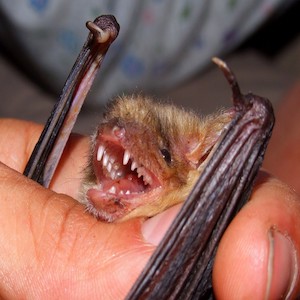Bats of Sicily: historical evidence, current knowledge, research biases and trends

Accepted: 18 July 2023
SUPPORTING INFORMATION: 241
All claims expressed in this article are solely those of the authors and do not necessarily represent those of their affiliated organizations, or those of the publisher, the editors and the reviewers. Any product that may be evaluated in this article or claim that may be made by its manufacturer is not guaranteed or endorsed by the publisher.
Authors
Insular bat communities are a preeminent conservation taxon due to their ecological role and intriguing and unique species composition. Sicily is the largest island in the Mediterranean. However, research on Sicilian bats is still scattered, with substantial information being overlooked. Here we present a systematic review of all available bibliographic information from 1810 to 2022, including grey literature, archives, and peer-reviewed publications. The analyses of bibliographic sources permitted us to evaluate the status of research on bats using the Bat Research Efficiency (BRE) and Species-Research Effort Allocation (SREA) metrics. A total of 81 documents were obtained. Since 1955, an average of 1.2 contributions have been issued per year. Over half of the documents are in Italian. The studies are primarily conducted in north-western (40%) and south-eastern (28%) Sicily, mainly in the provinces of Palermo and Siracusa. Most of the contributions concern “Species records” (61%) and “Ecology” (21%). There were 28 species reported, but a significant bias exists towards Myotis myotis, Miniopterus schreibersii, Rhinolophus ferrumequinum, Myotis capaccinii, and Rhinolophus euryale. Around 31.5% of the studies focused on threatened species, while 68.5% concentrated on non-threatened species, with an overall preference for cave-dwelling species. Yet, SREA analysis demonstrates a lack of research efforts for all species. We encourage the use of a multidisciplinary approach towards under-studied species while covering geographical gaps and increasing public awareness of the functional role of bats in natural ecosystems.
Cover Image: credits Saxifraga - Rudmer Zwerver
How to Cite

This work is licensed under a Creative Commons Attribution-NonCommercial 4.0 International License.
PAGEPress has chosen to apply the Creative Commons Attribution NonCommercial 4.0 International License (CC BY-NC 4.0) to all manuscripts to be published.
Similar Articles
- Pekka Niemelä, Timo Vuorisalo, Simo Örmä, Frederick II of Hohenstaufen and modern ecology , Natural History Sciences: Vol. 8 No. 2 (2021)
- Rita Scardino, Marco Arculeo, Vincenzo Arizza, Giuseppe Bazan, Mario Lo Valvo, Federico Marrone, Luca Vecchioni, New distributional data on Haemogregarina stepanowi (Apicomplexa) and Placobdella costata (Hirudinea) parasitising the Sicilian pond turtle Emys trinacris (Testudines) , Natural History Sciences: Vol. 9 No. 1 (2022)
- Orlando Gallo, Arnaldo Iudici, Rosario Balestrieri, Farther inland invasion of Finlayson’s squirrel Callosciurus finlaysonii (Horsfield 1823) poses a new conservation challenge for the endemic near threatened Calabrian black squirrel Sciurus meridionalis Lucifero 1907 (Rodentia: Sciuridae) , Natural History Sciences: Vol. 11 No. 2 (2024)
- Semyon Ya. Tsalolikhin, Aldo Zullini, Marine and freshwater taxa: some numerical trends , Natural History Sciences: Vol. 6 No. 2 (2019)
- Holiness Warjri, Jayaditya Purkayastha, Madhurima Das, An insight into the bioacoustics of some anurans of Meghalaya, India (Amphibia: Anura) , Natural History Sciences: Early Access
- Alexander S. Konstantinov, Madison F. Dorr, Longitarsus leonardicarloi (Coleoptera: Chrysomelidae: Galerucinae: Alticini), new species from Turkmenistan , Natural History Sciences: Vol. 10 No. s1 (2023)
- Agostino Brusco, Roberto Marchianò, Giuseppe Dodaro, Corrado Battisti, Non-volant mammals of the ‘Lago di Tarsia’ Regional Nature Reserve and Special Conservation Area (IT93100055; Cosenza, Southern Italy) , Natural History Sciences: Vol. 9 No. 2 (2022)
- Milo Manica, Lorenzo Laddaga, New records of Austropotamobius pallipes (Decapoda: Astacidae) relict populations from the Ticino River , Natural History Sciences: Vol. 10 No. 1 (2023)
- Enrico Banfi, Paola Caccia, Agnese Visconti, Archive reports and memories. The Brera Botanical Garden of Milan (1982-2001) , Natural History Sciences: Vol. 10 No. 2 (2023)
- Andrea Lombardo, Giuliana Marletta, No longer so common: findings of Calliopaea bellula d’Orbigny 1837 (Gastropoda: Sacoglossa) and Tayuva lilacina (A. Gould 1852) (Gastropoda: Nudibranchia) along the central-eastern coast of Sicily (Ionian Sea) , Natural History Sciences: Vol. 10 No. 1 (2023)
You may also start an advanced similarity search for this article.


 https://doi.org/10.4081/nhs.2023.680
https://doi.org/10.4081/nhs.2023.680






